Aditya Singh
Where is this grassroots initiative implemented? Who are the promoters? Who are the beneficiaries?
Biome Environmental Trust is a non-profit organization led by Vishwanath Srikantaiah (a water conservation expert), which launched the ‘A Million Wells for Bengaluru’ movement in the city of Bengaluru, Karnataka, India. This movement aims to have one million functioning open recharge wells in the city, allowing the recharge of aquifers and raising the underground water table.
A majority of the water requirements of Bengaluru are currently supplied by the Cauvery River flowing 100km south of the city. Cauvery water is pumped up about 300m (984ft) to reach the city, requiring large amounts of energy. The borewells in the city (although there are no official measures) provide 600-700 million litres of groundwater, making up about 35- 40% of the city’s water requirement.
Historically, open and shallow recharge wells (presently, only about 20,000 to 30,000) that access higher aquifers were the providers of water to the citizens. However, they have now slowly been replaced by borewells (presently, about 500,000), which are narrow boreholes that exploit and drain the lower aquifers (now gone down to about 1,800 feet).
In terms of rainfall, only about 3-10% of the city’s rains percolates into underground aquifers naturally based on hydrological patterns. However, land begins to ‘crust’ upon urban development and construction, bringing down the percolation to 0-1%. Precious rainwater flows down buildings and tarred roads as surface run-off, choking sewers and inundating low-lying areas (leading to urban flooding). Moreover, these problems have worsened over several decades due to climate change.
‘A Million Wells for Bengaluru’ aims to provide a solution to these problems, and in the process, secure livelihoods for the ‘Mannu Vaddars,’ a local well-digging community native to the region. The overall percolation rate of rainwater can be increased (up to 50-60%) using open recharge wells. Vishwanath calculates that 1 million wells will be enough to solve issues of water shortage in the city. If even a portion of the 3.5 million litres that falls onto each acre of land in the city as rainfall percolates into the ground, water requirements would be met without supply from the Cauvery River. Additionally, water from open recharge wells is more affordable (around 1% of the price of Cauvery water) than from borewells and the Cauvery, only being pumped up a mere 6m (20ft) to the surface, as opposed to a 100km length and 300m height.
‘A Million Wells for Bengaluru’ has been supported and promoted by native and local communities, institutions, citizen groups, and governmental agencies, given the wide-ranging benefits of the movement that can be observed by all citizens of the city.
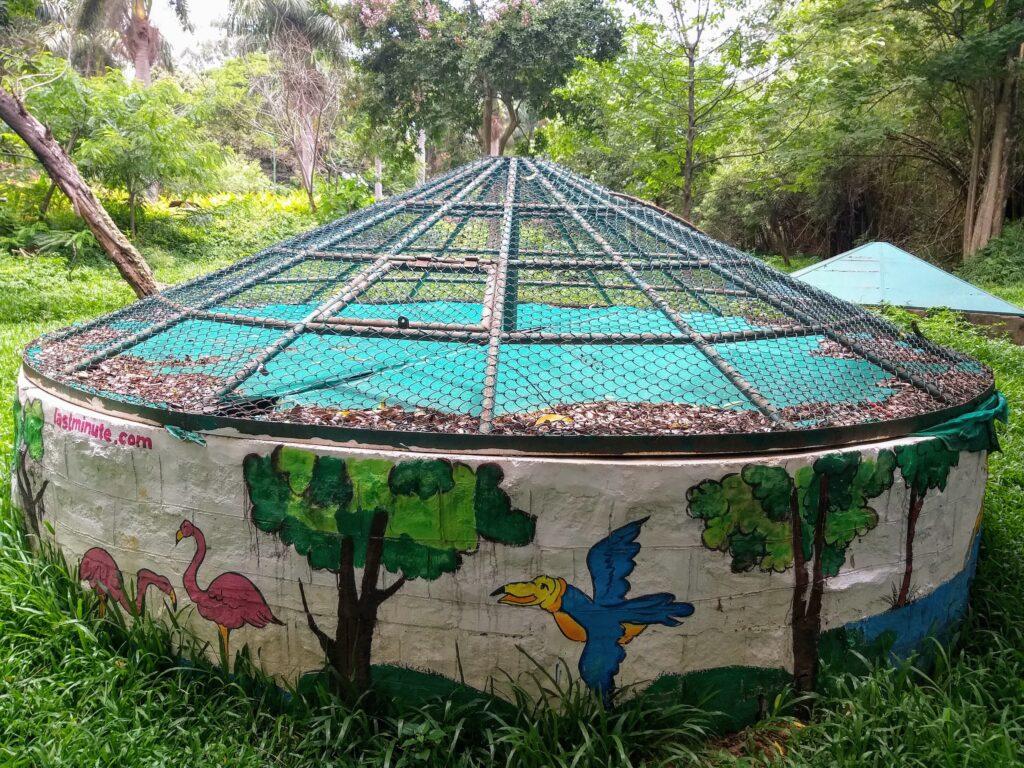
Open recharge well in the city
Image courtesy of Mr. Vishwanath Srikantaiah
How does this initiative engage with climate? Does it tackle mitigation, adaptation, both, or other dimensions of climate change?
The movement is directly mitigating the impacts of climate change. Vishwanath explains that rainfall patterns in Bengaluru, like many other cities, have changed dramatically over time with intense showers within short durations, leading to larger volumes of water being dumped over the city very quickly, and in unexpected months.
The Karnataka State Natural Disaster Monitoring Centre (KSNDMC) has set up about 100 weather stations across every other ward in the city. Biome Trust, along with the KSNDMC, has been tracking the change in rainfall patterns due to climate change and has found an increase in the intensity of rainfall from 60mm per hour to about 180mm per hour. Additionally, the pockets of the city that were previously not getting enough rain are getting higher amounts now.
With recharge wells, rainwater can be routed into the shallow aquifers more efficiently, enhancing the groundwater levels gradually by mimicking the natural patterns observed decades ago. The recharge wells capture the high intensity of rainfall instead of allowing it to flood. The collected water then percolates into the ground and recharges aquifers, which are water-bearing formations that exist 10-100 ft underground, and are naturally replenished during rains.
Water from an open well requires 0.1 units of energy for every thousand litres of water supplied, in relation to the 1.5 – 1.8 units from deep bore wells and 2 units for Cauvery water. Therefore, recharge wells provide water that is 20 times more efficient compared to Cauvery water, with their carbon emissions being 20 times less.
Hence, the movement is engaging directly with the climate, responding to the vagaries of rainfall, and mitigating urban flooding, both consequences of climate change. It is recharging the groundwater table and lakes of the city through increased percolation to solve issues of water scarcity. Finally, open wells also reduce energy consumption and carbon emissions in providing water to the city, both important facets of climate change.
What are the main objectives? What are the main values?
For ease of understanding, the main objectives of this movement could be categorized into social and practical ones. Vishwanath explains that one of the larger social objectives is to provide and secure livelihoods for the well digging Mannu Vaddar community, native to Karnataka. This would allow higher rates of education within the community, giving the future generations the power to decide whether they would want to pursue well digging, or another field of their choosing.
According to Vishwanath, an important social objective is to raise awareness about the presence of open recharge wells in the city, the potential of shallow aquifers to sustain water requirements of the city, and the role of local communities in their revival. Within this, the hope is to build a water culture in the city where local citizens take collective responsibility for managing groundwater through community participation and the mainstreaming of bottom-up and traditional water harvesting practices.
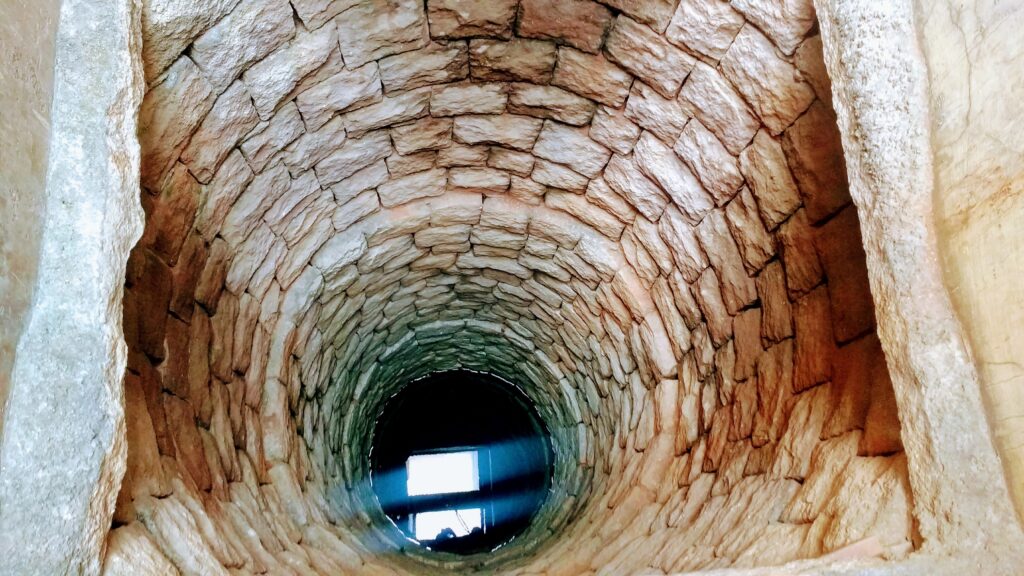
Old stone-lined well recharged with rainwater
Image courtesy of Mr. Vishwanath Srikantaiah
A practical objective of the movement, Vishwanath describes, is to bring up the water table in the city, where open recharge wells (and borewells) would then be able to supplement water requirements. With this, it was also important to ensure the productive use of rainwater and to bring awareness to the importance of rainwater harvesting practices to capture rainwater.
Another practical objective of the movement is to engage with the climate and mitigate the impacts of climate change. As explained previously, through recharging of shallow aquifers, open recharge wells will be able to prevent flooding, reduce energy consumption and carbon emissions, and solve issues of water shortage in the city, by ensuring water security.
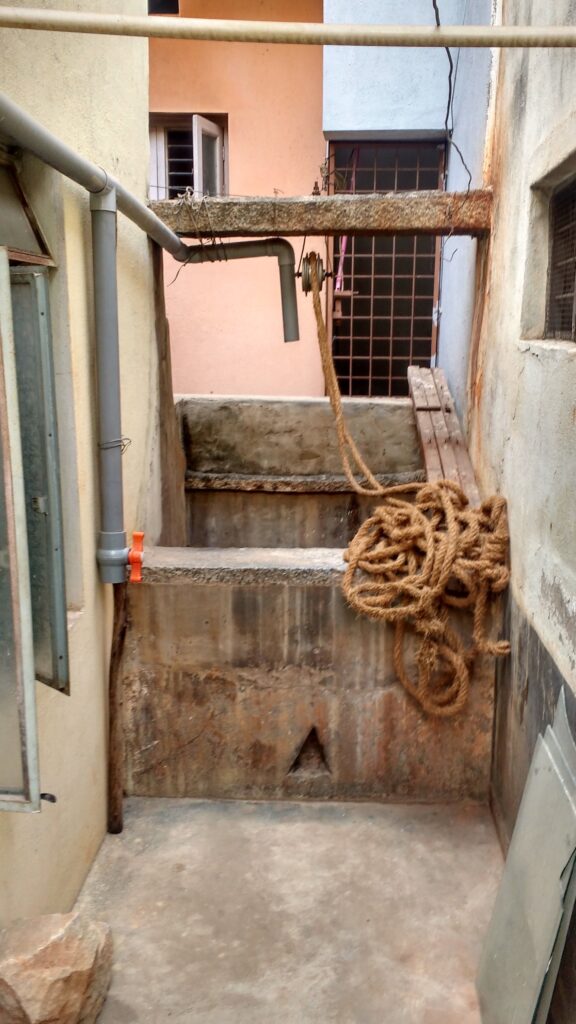
Rooftop rainwater recharging a well
Image courtesy of Mr. Vishwanath Srikantaiah
What is the timeline? Are there already visible effects?
Understood as a movement instead of a project, ‘A Million Wells for Bengaluru’ was launched in 2015. As it is providing livelihoods, it does not follow a regular project timeline and is more open-ended in its scope. Since it is not possible to track every well that has come up in the city, there cannot be a definite start time to the larger process, given that well diggers have been digging wells for centuries. One million wells are an aspirational goal that has been set for the city and is not the end goal since the movement should continue to grow with urban growth and rising populations. However, the hope is to reach one million wells by 2025.
There are several instances at an individual, institutional and public level that highlight the visible effects of the increased awareness about the open recharge wells. Institutions have taken the initiative to set up recharge wells themselves. Through the restoration of 4 open recharge wells within the Wheel and Axle Railway Plant campus in the city, the wetlands around the wells were revived. With a variety of birds coming to the wetlands, one can observe larger environmental impacts of engagement with the wells. Most importantly, the wells now provide the plant with 300,000 litres of water, and they no longer require water from the Bangalore Water Supply and Sewerage Board (BWSSB). Similarly, in Cubbon Park, one of Bengaluru’s largest open spaces, defunct open recharge wells on restoration provide 100,000 litres of water to the park.
Who are the actors involved? What is their background?
As per the Memorandum of Understanding signed for the movement, Biome Environmental Trust provides the technical support for it through consultations with architects, civil and mechanical engineers, and urban planners; Friends of Lakes is the implementation partner that organises voluntary community engagements to clean the city’s lakes; India Cares Foundation is the enabler taking care of fundraising. All investments made within this movement are by individuals, institutions, and communities across the city, all crucial actors for the success of the movement.
Vishwanath Srikantaiah (of the Biome Environmental Trust) has been working in the water sector in Bengaluru for 34 years. He has travelled all across the world (to Iran, China, Sri Lanka, Indonesia, Brazil, Chile, Sweden, Finland, Latvia, etc.) to study wells. He explains that large governmental infrastructural projects provide one type of solution for the water shortage, which occurs in the city every 20 years since the 1850s, due to its expansion. The other way is for the local citizens to participate in the solution through community involvement and action.
The Bangalore Water Supply and Sewerage Board (BWSSB) offer policy support to the movement. Vishwanath, who has been a proponent of rooftop rainwater harvesting (RWH), has been working with BWSSB, helping them write the bylaws (based on the rainfall patterns in the city) to make rainwater harvesting compulsory in the region. Water from RWH can be filtered and supplied into open wells, which would then recharge the aquifers, supplementing the piped water supply of the city.
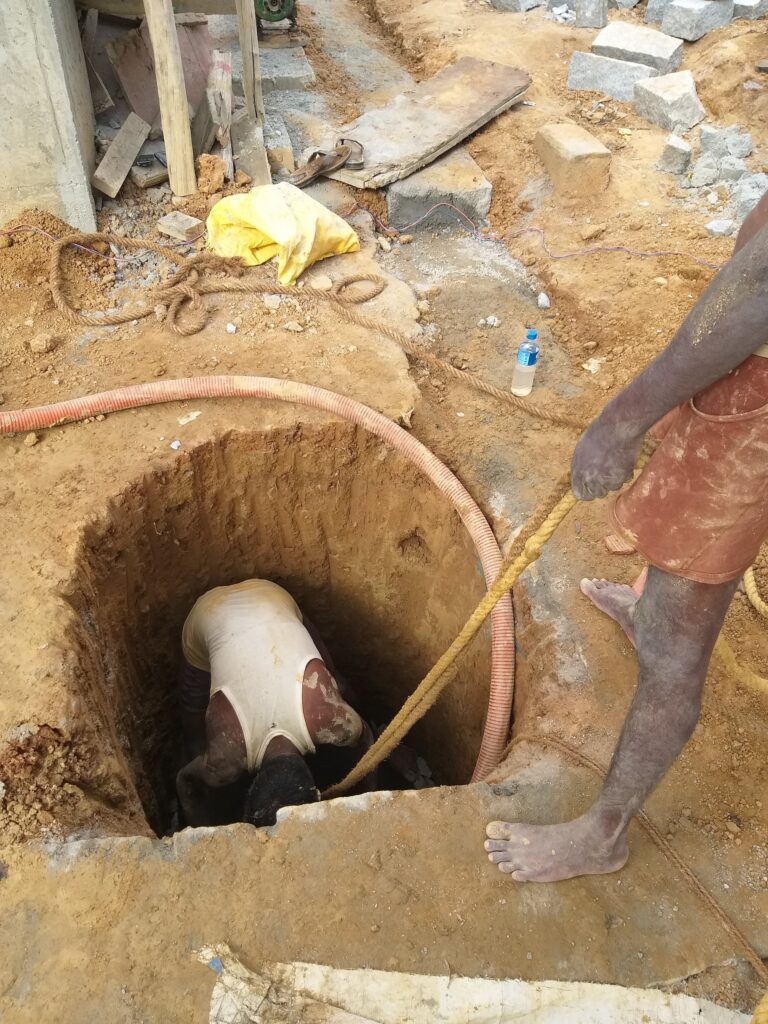
Mannu Vaddars digging a recharge well
Image courtesy of Mr. Vishwanath Srikantaiah
The Mannu Vaddars (a sub-caste of the Bhovi community) have been historically digging tanks, lakes, and wells across the country for over 1000 years. They have traditionally found work given their knowledge of digging and maintaining wells. However, they are now running short of livelihoods since people have started drilling borewells instead of open wells. Biome began seeking out the traditional well diggers that constitute 750 families living in and around the city. Their skills and knowledge of the region’s hydrogeology (aquifers, pre-existing wells, soil types, presence of rocky layers) have been pivotal in achieving the goals for this movement.
Which limits (institutional, physical, social, etc.) does it encounter?
There are a few limitations that the movement encounters. The first social limitation would be the resistance towards understanding the impacts of climate change on the ecosystem. There can also be a lack of responsibility among citizens towards recognizing the importance of rainwater harvesting and open recharge wells as required infrastructure systems.
Topographically, certain areas in the city may not be conducive for recharge wells because of hard layers of rock and clay, creating an ecological limitation in specific locations. Additionally, appropriate mapping techniques like Geographic Information Systems (GIS) and Remote Sensing are required to understand geological features to decide the areas where open wells could be feasible. However, these technologies are not available with civic and administrative agencies, constituting a severe institutional limitation.
Are any shortcomings or critical points visible? What other problematic issues can arise from its implementation?
Since the recharge wells utilize bio-mimicry to imitate natural ecological processes, no negative effects have been observed since they are holding the water that would have been held by an un-built site.
One crucial point for the entire movement is that native well-digger communities must be provided with employment opportunities within these projects. It would be antithetical to employ modern technological methods, and people that do not belong to the Mannu Vaddar community for digging wells.
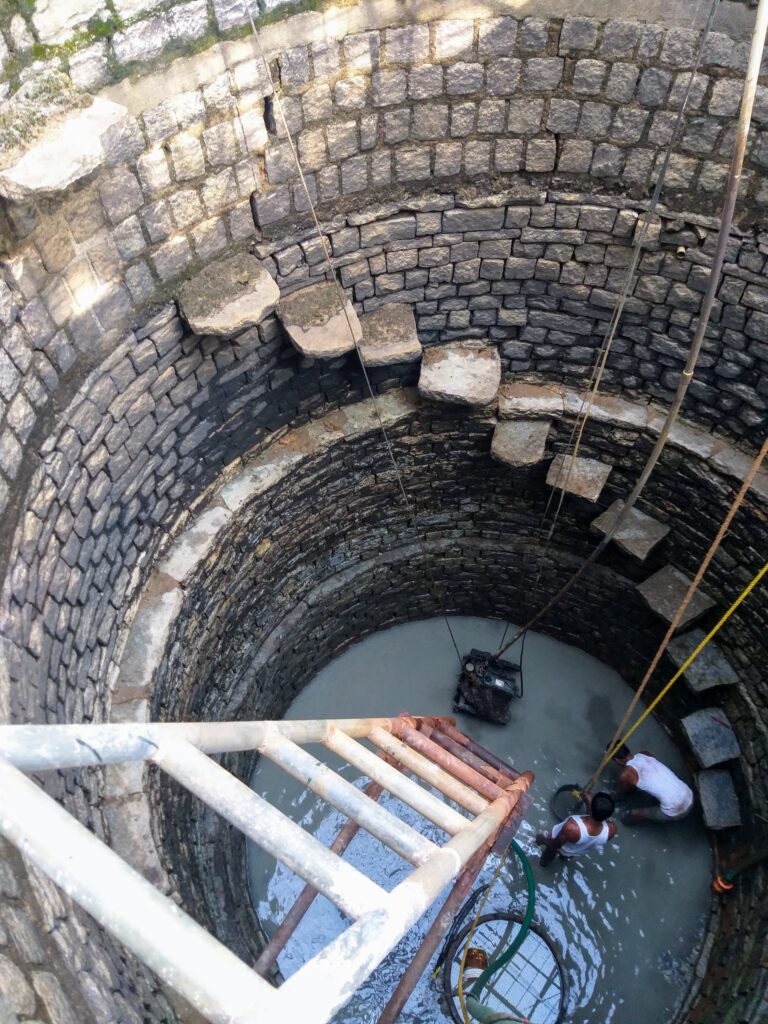
Mannu Vaddars cleaning and desilting a recharge well
Image courtesy of Mr. Vishwanath Srikantaiah
How would it be potentially replicable in other settings?
The movement can and has been replicated in several other locations based on the specific needs and context of the region. Open wells, if recharged, can provide arsenic- and fluoride- free water to the regions where contaminated water is currently being consumed.
Vishwanath mentions that the aim of the movement is that it should not matter if the Biome Trust is involved in its continuation. Biome does not claim credit for the movement and considers their responsibility to provide an aspirational goal, and to bring awareness, encouraging individuals, communities, and institutions to dig wells within their localities, and share their stories with the Biome Trust, if they wish to do so.
Several cities such as Hyderabad, Belgaum, Sangli, Tiruchirappalli, Chennai, have launched their own movements or similar initiatives. Additionally, The Ministry of Urban Development has been in correspondence with Biome to officially incorporate this movement into the Jal Shakti Program under the Smart Cities Project for 500 cities across the country.
The revival of the shallow aquifer is being replicated – leading to an all-India movement, where the open well, as a representative of the shallow aquifer is reaching every village, town, and city in India.
Is this initiative conducive to broader changes (law, institutional arrangements, long term sustainability or community preparedness, etc.)? If yes, which?
The movement has highlighted the importance of engaging with local contexts and features, talking to people whose livelihoods depend on the water (farmers, fishers, well-diggers), learning from their experiences, and involving them within the solution. The mainstreaming of this practice leads to better community preparedness for mitigating the effects of the climate crisis.
Individuals, institutions, large and small establishments, gated communities, have all taken up initiatives without the involvement of Biome. The movement has enabled individual citizens and communities to take action, brought larger awareness to how they can be involved within climate change action, which need not necessarily be at an administrative level through large infrastructure projects.
MLAs and Corporators (elected officials) across the city have started planning and making recharge wells in their respective constituencies and zones. The Deputy Chief Minister of Karnataka, C.N. Ashwath Narayan, initiated the digging of 100 recharge wells in the Malleshwaram constituency. The State Horticultural Department has taken this initiative to all the parks in the city including Lalbagh Botanical Gardens, which now has 500 recharge wells. The Bellandur Development Forum has planned to dig 2,500 wells in low-lying areas around Bellandur Lake that get inundated with rainwater during the monsoon.
A crucial part of the movement has been the mandating of climate change action by the government through the rainwater harvesting bylaws, highlighting how sustainable practices could be institutionalized through legislation and policy.
References
Interview conducted with Mr. Vishwanath Srikantaiah
Coushik, R. (2020). The Indian megacity digging a million wells. Retrieved from https://www.bbc.com/future/article/20201006-india-why-bangalore-is-digging-a-million- wells
Gatty, H.R. (2020). Two years, one lakh wells: Can “Million Wells” movement help sove Bengaluru’s water crisis. Retrieved from https://bengaluru.citizenmatters.in/million-recharge-wells-biome- friends-of-lakes-rainwater-harvesting-43978
N.A (2018). Urban Waters Bengaluru: Million Wells. Retrieved from http://bengaluru.urbanwaters.in/million-wells/
Padre, I. (2019). A million wells for Bengaluru. Retrieved from https://www.civilsocietyonline.com/cover-story/a-million-wells-for-bengaluru/
Priya, L. (2019). One Million Wells for Bengalurur: Meet The Group Saving The City from Day Zero! Retrieved from https://www.thebetterindia.com/173853/bengaluru-ground-water-crisis-well- digging-day-zero-zenrainman/
Ramchandran, S. (2019). TEDdxBangalore: The Answer to India’s Water Crisis: Community. Retrieved from https://www.youtube.com/watch?v=AxlKrJcg8KU&t=22s
Srikantaiah, V. (2020). TEDxMBSITM: A city and its waters. Retrieved from https://www.youtube.com/watch?v=velaVjFWv1A&t=48s